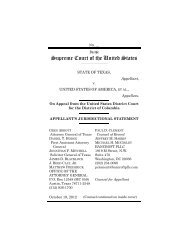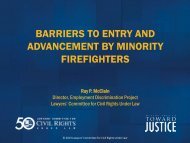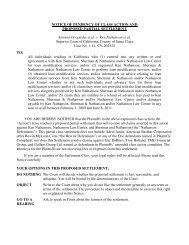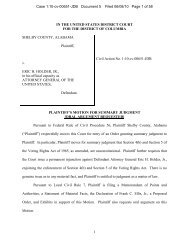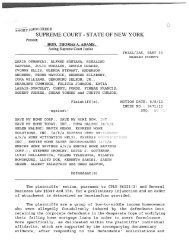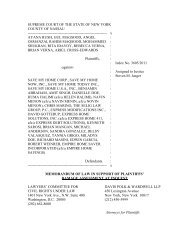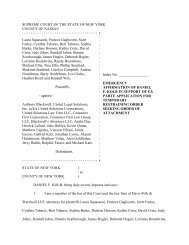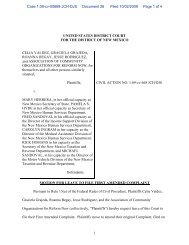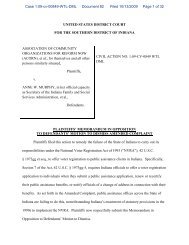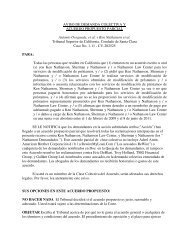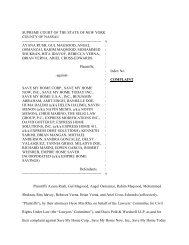Police in Schools are Not the Answer to the Newtown Shooting - Jan ...
Police in Schools are Not the Answer to the Newtown Shooting - Jan ...
Police in Schools are Not the Answer to the Newtown Shooting - Jan ...
- No tags were found...
Create successful ePaper yourself
Turn your PDF publications into a flip-book with our unique Google optimized e-Paper software.
These experiences can breed widespread resentment, distrust, and hostility among youth, directed at<strong>the</strong> very people charged with keep<strong>in</strong>g <strong>the</strong>m safe. In many cases, <strong>the</strong>se young people may resent be<strong>in</strong>gtreated as crim<strong>in</strong>als; may lose faith <strong>in</strong> <strong>the</strong> goodwill of police when <strong>the</strong>y believe <strong>the</strong>y <strong>are</strong> be<strong>in</strong>g treatedunfairly; and may become antagonistic <strong>to</strong>ward law enforcement <strong>in</strong> response. 65 Problems like <strong>the</strong>secannot simply be solved by more tra<strong>in</strong><strong>in</strong>g for police. Indeed, it is <strong>the</strong> very <strong>in</strong>volvement of police <strong>in</strong>school discipl<strong>in</strong>e that disrupts <strong>the</strong> learn<strong>in</strong>g environment by dim<strong>in</strong>ish<strong>in</strong>g students’ belief <strong>in</strong> <strong>the</strong> legitimacyof school staff authority and by creat<strong>in</strong>g an adversarial relationship between school officials andstudents. 66In addition, plac<strong>in</strong>g more law enforcement <strong>in</strong> schools distracts <strong>the</strong>m from <strong>the</strong>ir role of ensur<strong>in</strong>g safety <strong>in</strong>our schools and <strong>in</strong> our communities. Redirect<strong>in</strong>g police resources <strong>to</strong> schools means that police officersspend more time as school discipl<strong>in</strong>arians and dedicate less time <strong>to</strong> ensur<strong>in</strong>g <strong>the</strong> safety of students and<strong>the</strong> community. As <strong>the</strong> International Association of Chiefs of <strong>Police</strong> noted, “<strong>the</strong> deployment of at least 1officer <strong>to</strong> each of <strong>the</strong> roughly 100,000 schools <strong>in</strong> this nation would result <strong>in</strong> <strong>the</strong> reassignment of nearly1/7th of American law enforcement officers.” 67 Law enforcement should be allowed <strong>to</strong> concentrate<strong>the</strong>ir efforts on prevent<strong>in</strong>g, <strong>in</strong>vestigat<strong>in</strong>g, and respond<strong>in</strong>g <strong>to</strong> crime where it is occurr<strong>in</strong>g. The majority ofviolent crimes aga<strong>in</strong>st youth take place outside of school. The Bureau of Justice Statistics’ Indica<strong>to</strong>rs ofSchool Crime and Safety <strong>in</strong>dicate that, <strong>in</strong> 2010, only a small fraction of all youth homicides occur <strong>in</strong>school, 68 And only a small fraction of youth deaths <strong>are</strong> <strong>the</strong> result of homicides that occur <strong>in</strong> school. 69However, <strong>in</strong>stead of hav<strong>in</strong>g law enforcement personnel devote <strong>the</strong>ir energies <strong>to</strong> what <strong>the</strong>y were tra<strong>in</strong>ed<strong>to</strong> do, which is <strong>to</strong> address serious crim<strong>in</strong>al behaviors that erode public safety and public health, <strong>the</strong>y <strong>are</strong>placed <strong>in</strong> schools where <strong>the</strong>y tend <strong>to</strong> spend valuable time on m<strong>in</strong>or or even trivial offenses. Thiscompromises, ra<strong>the</strong>r than enhances public safety, because time that could be spent address<strong>in</strong>g <strong>the</strong>complex challenges associated with serious crimes is <strong>in</strong>stead spent respond<strong>in</strong>g <strong>to</strong> school behaviors.The consequences of plac<strong>in</strong>g police <strong>in</strong> school <strong>are</strong> <strong>in</strong>credibly high – particularly for youth of color,students with disabilities, gender non-conform<strong>in</strong>g students, and LGBTQ youth. The decision <strong>to</strong> placemore police <strong>in</strong> school must balance <strong>the</strong> valid need for school security with <strong>the</strong> risks and drawbacks ofhav<strong>in</strong>g law enforcement <strong>in</strong> our schools. Here, <strong>the</strong> costs <strong>are</strong> high and <strong>the</strong> ga<strong>in</strong>s <strong>are</strong> m<strong>in</strong>imal: <strong>the</strong>re is noclear correlation between police <strong>in</strong> schools and student safety, and plac<strong>in</strong>g more police <strong>in</strong> schools clearlyharms <strong>the</strong> relationships between youth and adults, <strong>in</strong>creases <strong>the</strong> likelihood that students will bearrested for age-appropriate behaviors, and fails <strong>to</strong> address <strong>the</strong> root causes of violence. The proposals<strong>to</strong> <strong>in</strong>crease <strong>the</strong> police presence <strong>in</strong> schools follow<strong>in</strong>g Sandy Hook is counter<strong>in</strong>tuitive and goes aga<strong>in</strong>steveryth<strong>in</strong>g that we know about <strong>the</strong> best way <strong>to</strong> ensure that youth <strong>are</strong> <strong>in</strong> school communities that <strong>are</strong>supportive, safe, and effective.65 See Jeffrey Fagan & Tom Tyler. Legal Socialization of Children and Adults, 24 Social Justice Research 241-247(2005).66 See Meyer & Leone, supra note 58 at 352; Randall R. Beger, supra note 57 at 340.67 Press Release, International Association of Chiefs of <strong>Police</strong>, Statement of IACP President Craig Steckler onProposal <strong>to</strong> Place Armed <strong>Police</strong> Officers <strong>in</strong> All <strong>Schools</strong> (Dec. 21, 2012)(on file with authors).68 Indica<strong>to</strong>rs of School Crime and Safety: 2011, supra note 17.69 Center for Disease Control, National Center for Injury Prevention and Control,http://webappa.cdc.gov/sasweb/ncipc/leadcaus10_us.html (prep<strong>are</strong>d by Professor Dewey Cornell, Curry School ofEducation, University of Virg<strong>in</strong>ia. All annual <strong>to</strong>tals <strong>are</strong> approximate, us<strong>in</strong>g <strong>the</strong> school year for school homicides and<strong>the</strong> calendar year for non-school data).13



